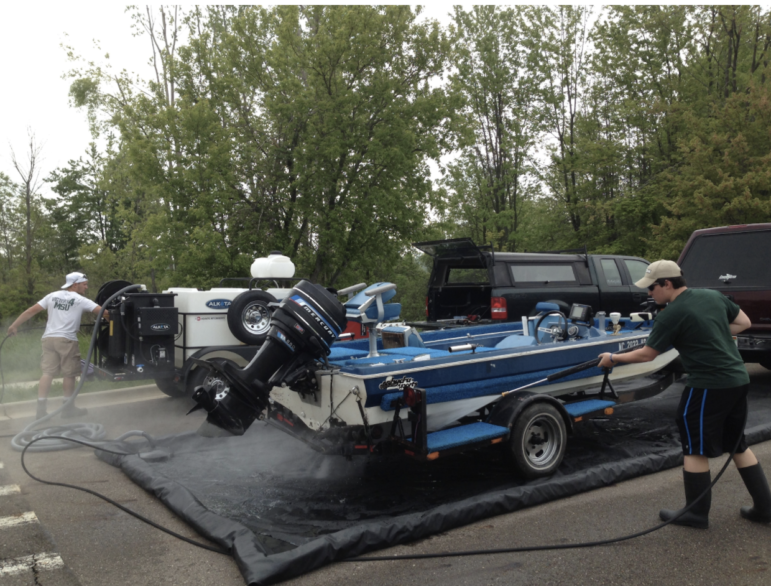By JACK FALINSKI
Capital News Service
LANSING — When you think of common spots to learn about Michigan’s invasive species, some that come to mind are schools, museums, zoos and aquariums.
Not bars … or at least not until now.
A new project in Northwest Michigan will bring awareness to the impact of off-road vehicles (ORVs) in transporting invasive species from one area to another.
These lessons won’t be taught just on the trails, though.
“In our area, there’s a certain number of bars and restaurants that really cater to ORV recreationists, so we would be leaving our ORV trailhead event where we talked to 11 people, and we’d drive by a bar where we saw 50 ORVs,” said Vicki Sawicki, the program coordinator for the North Country Cooperative Invasive Species Management Area, headquartered in Cadillac.
“Now, we’re going into those bars and doing invasive species trivia and giving cool prizes,” Sawicki said.

Department of Environment, Great Lakes and Energy
A portable boat wash operating at Lake Ovid in Clinton County.Earlier this month, the state awarded $3.6 million in grants to 31 invasive species projects.
The fledgling ORV program received $234,400 and will serve Lake, Mason, Mecosta, Missaukee, Osceola and Wexford counties.
As with boats being moved from one body of water to another, Sawicki said riders should wash their vehicles after traversing trails that can go deep into the backcountry. That can prevent any lingering invasives, like garlic mustard or wild parsnip, from catching a ride to another part of the state.
“It’s kind of a badge,” Sawicki said. “People like getting their vehicles all muddy. It shows what a wild time they had on the trail.
“But it’s really risky to take that mud home.”
In addition to trivia games at local bars, Sawicki said project members will survey 500 miles of trails in the six counties to look for invasive species, plant signs along trails indicating where local car washes are and create a hashtag movement to engage communities in safe trail practices.
Joanne Foreman, the communications coordinator for the Invasive Species Program with the Michigan Department of Natural Resources, said such programs are important because they can be implemented further throughout the state if they’re successful..
Michigan has 21 regional cooperative invasive species management areas, or CISMAs, that serve all 83 counties.
Collaboration among these regional agencies, Foreman said, has increased research, engagement and awareness of invasive species.
“The nice thing about the grant program and the CISMAs themselves is that they share results,” Foreman said. “I’m sure that North Country CISMA, as their project progresses, it’s going to be sharing what it’s doing with all the other 20 in the state.”
The program started in 2014 when the Legislature provided it with $5 million. Since then, it has garnered $29 million to support 202 projects and has allowed recipients to survey over 548,000 acres, treat over 44,000 acres infested by invasives and directly contact more than 257,000 people about ways to prevent transmission.
Foreman said the goals of these grants remain funding research, promoting outreach and education and enhancing the work of local CISMAs, which she described as “boots on the ground” for controlling invasive species in Michigan.